総説
Dynamical Systems Approach to Endothelial Heterogeneity
Erzsébet Ravasz Regan and William C. Aird
Circulation Research. 2012;111:110-130
Endothelial cells display remarkable phenotypic heterogeneity. An important goal is to elucidate the scope and mechanisms of endothelial heterogeneity and to use this information to develop vascular bed–specific therapies. We reexamine our current understanding of the molecular basis of endothelial heterogeneity. We introduce multistability as a new explanatory framework in vascular biology. We draw on the field of nonlinear dynamics to propose a dynamical systems framework for modeling multistability and its derivative properties, including robustness, memory, and plasticity. Our perspective allows for both a conceptual and quantitative description of system-level features of endothelial regulation.
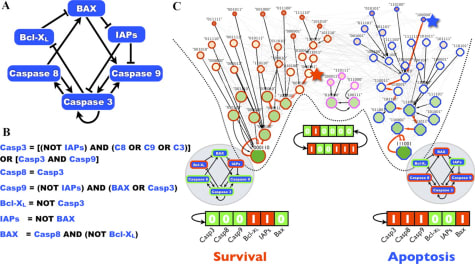
Boolean model of a caspase-mediated survival-apoptosis switch
血管内皮細胞の細胞内情報伝達を良くまとめている総説です。ダイナミックセオリーも,その通りというところがたくさんあります。
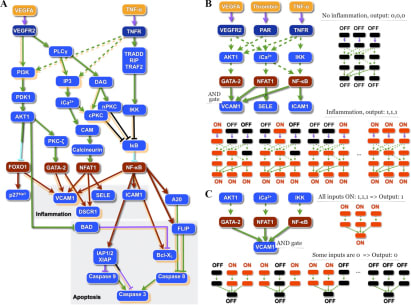
Agonist-mediated signaling pathways with cross-talk
原著論文
1. Inefficient Reprogramming of Fibroblasts into Cardiomyocytes Using Gata4, Mef2c, and Tbx5
Jenny X. Chen, Markus Krane, Marcus-Andre Deutsch, Li Wang, Moshe Rav-Acha, Serge Gregoire, Marc C. Engels, Kuppusamy Rajarajan, Ravi Karra, E. Dale Abel, Joe C. Wu, David Milan, and Sean M. Wu
Circulation Research. 2012;111:50-55
Rationale: Direct reprogramming of fibroblasts into cardiomyocytes is a novel strategy for cardiac regeneration. However, the key determinants involved in this process are unknown.
Objective: To assess the efficiency of direct fibroblast reprogramming via viral overexpression of GATA4, Mef2c, and Tbx5 (GMT).
Methods and Results: We induced GMT overexpression in murine tail tip fibroblasts (TTFs) and cardiac fibroblasts (CFs) from multiple lines of transgenic mice carrying different cardiomyocyte lineage reporters. We found that the induction of GMT overexpression in TTFs and CFs is inefficient at inducing molecular and electrophysiological phenotypes of mature cardiomyocytes. In addition, transplantation of GMT infected CFs into injured mouse hearts resulted in decreased cell survival with minimal induction of cardiomyocyte genes.
Conclusions: Significant challenges remain in our ability to convert fibroblasts into cardiomyocyte-like cells and a greater understanding of cardiovascular epigenetics is needed to increase the translational potential of this strategy.
2. コロニンsiRNA
Role of Coronin 1B in PDGF-Induced Migration of Vascular Smooth Muscle Cells
Holly C. Williams, Alejandra San Martín, Candace M. Adamo, Bonnie Seidel-Rogol, Lily Pounkova, Srinivasan Raju Datla, Bernard Lassègue, James E. Bear, and Kathy Griendling
Circulation Research. 2012;111:56-65
Rationale: The type I subclass of coronins, a family of actin-binding proteins, regulates various actin-dependent cellular processes, including migration. However, the existence and role of coronins in vascular smooth muscle cell (VSMC) migration has yet to be determined.
Objective: The goal of the present study was to define the mechanism by which coronins regulate platelet-derived growth factor (PDGF)–induced VSMC migration.
Methods and Results: Coronin 1B (Coro1B) and 1C (Coro1C) were both found to be expressed in VSMCs at the mRNA and protein levels. Downregulation of Coro1B by siRNA increases PDGF-induced migration, while downregulation of Coro1C has no effect. We confirmed through kymograph analysis that the Coro1B-downregulation-mediated increase in migration is directly linked to increased lamellipodial protraction rate and protrusion distance in VSMC. In other cell types, coronins exert their effects on lamellipodia dynamics by an inhibitory interaction with the ARP2/3 complex, which is disrupted by the phosphorylation of Coro1B. We found that PDGF induces phosphorylation of Coro1B on serine-2 via PKCɛ, leading to a decrease in the interaction of Coro1B with the ARP2/3 complex. VSMCs transfected with a phosphodeficient S2A Coro1B mutant showed decreased migration in response to PDGF, suggesting that the phosphorylation of Coro1B is required for the promotion of migration by PDGF. In both the rat and mouse, Coro1B phosphorylation was increased in response to vessel injury in vivo.
Conclusions: Our data suggest that phosphorylation of Coro1B and the subsequent reduced interaction with ARP2/3·complex participate in PDGF-induced VSMC migration, an important step in vascular lesion formation.
血管平滑筋には,Coronin 1BとICが存在する。
RT-PCR Primer
Coro1B (upstream primer, 5′-ACA TGT CCT TCC GAA AAG TTG TGC-3′; downstream primer, 5′-CTG ATC CAC TGG CAA TGA CTT CGT-3′);Coro1C (upstream primer, 5′-TGT CTT CAC TAC TGG TTT TAG CCG TA-3′; downstream primer, 5′-TCT AGC TTT GAA ATG CGC TCG TCT-3′); and GAPDH (upstream primer, 5′-AAT GGG GTG ATG CTG GTG CTG AGT A-3′; downstream primer, 5′-GGA AGA ATG GGA GTT GCT GTT GAA G-3′)
siRNA
Coro1B (5′-CAG CAC CTT CTG CGC AGT CAA-3′), Coro1c (5′-ACG AGA GAA AGT GTG AAC CTA-3′) and PKCɛ (5′-CCC GGG AAG AGC CAA TAC TTA-3′)
コロニンについて
Coronins are a family of evolutionarily conserved tryptophan (W) and aspartic acid (D)-repeat actin-binding proteins known to control a variety of cellular processes involving actin dynamics.The coronin protein family includes 7 proteins in mammals, separated into 3 subclasses (types I, II, and III) based on phylogenetic similarity.The type I coronins consist of coronin 1A (Coro1A), 1B (Coro1B), and 1C (Coro1C) and are the most studied coronin subfamily. Coro1A is highly expressed in cells of hematopoietic lineage in addition to various tissues of the nervous system, while having significantly lower expression in other tissues of the body.1On the other hand, Coro1B and Coro1C are more ubiquitously expressed at higher levels in most tissues.11 Coro1B localizes to the plasma membrane, regulates lamellipodia formation, and when phosphorylated is no longer able to bind ARP2/3 and inhibit its actin nucleation abilities. In contrast, in epithelial cells, Coro1C was demonstrated to regulate focal adhesion dynamics and increase wound closure. Thus, Coro1B and 1C can potentially influence migration via several different mechanisms, and their overall impact is likely to be a function of the complement of coronins expressed in a given cell type.
3. リアノジン受容体を介したCICR
Ryanodine Receptor Current Amplitude Controls Ca2+ Sparks in Cardiac Muscle
Tao Guo, Dirk Gillespie, and Michael Fill
Circulation Research. 2012;111:28-36
Rationale: In cardiac muscle, Ca2+-induced Ca2+ release (CICR) from the sarcoplasmic reticulum (SR) is mediated by ryanodine receptor (RyR) Ca2+ release channels. The inherent positive feedback of CICR is normally well-controlled. Understanding this control mechanism is a priority because its malfunction has life-threatening consequences.
Objective: We show that CICR local control is governed by SR Ca2+ load, largely because load determines the single RyR current amplitude that drives inter-RyR CICR.
Methods and Results: We differentially manipulated single RyR Ca2+ flux amplitude and SR Ca2+ load in permeabilized ventricular myocytes as an endogenous cell biology model of the heart. Large RyR-permeable organic cations were used to interfere with Ca2+ conductance through the open RyR pore. Single-channel studies show this attenuates current amplitude without altering other aspects of RyR function. In cells, the same experimental maneuver increased resting SR Ca2+ load. Despite the increased load, Ca2+ spark (inter-RyR CICR events) frequency decreased and sparks terminated earlier.
Conclusions: Spark local control follows single RyR current amplitude, not simply SR Ca2+ load. Spark frequency increases with load because spontaneous RyR openings at high loads produce larger currents (ie, a larger CICR trigger signal). Sparks terminate when load falls to the point at which single RyR current amplitude is no longer sufficient to sustain inter-RyR CICR. Thus, RyRs that spontaneously close no longer reopen and local Ca2+ release ends.
付録:TAM Receptor
Nature Reviews Immunology 8, 327-336 (May 2008)
Immunobiology of the TAM receptors
Recent studies have revealed that the TAM receptor protein tyrosine kinases ― TYRO3, AXL and MER ― have pivotal roles in innate immunity. They inhibit inflammation in dendritic cells and macrophages, promote the phagocytosis of apoptotic cells and membranous organelles, and stimulate the maturation of natural killer cells. Each of these phenomena may depend on a cooperative interaction between TAM receptor and cytokine receptor signalling systems. Although its importance was previously unrecognized, TAM signalling promises to have an increasingly prominent role in studies of innate immune regulation.
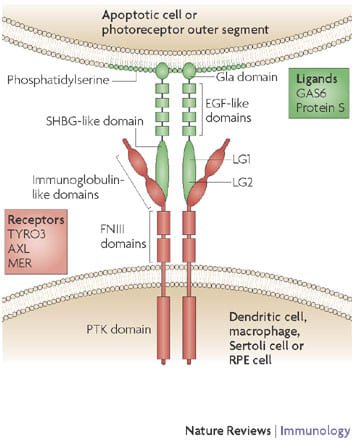
TYRO3 (also known as BRT, DTK, RSE, SKY and TIF), AXL (also known as ARK, TYRO7 and UFO) and MER (also known as EYK, NYM and TYRO12) are receptor protein tyrosine kinases (PTKs) that are expressed by dendritic cells, macrophages and immature natural killer (NK) cells of the immune system, Sertoli cells of the testis, retinal pigment epithelial (RPE) cells of the eye, and several other cell types. TAM receptor dimers bind to their two ligands, growth-arrest-specific 6 (GAS6) and protein S, through interaction between the two N-terminal immunoglobulin-like domains of the receptors and the two C-terminal laminin G (LG) regions, which together make up the SHBG (sex hormone binding globulin) domain, of the ligands. (The solved X-ray crystal structure of the GAS6 SHBG domain bound to the immunoglobulin domains of AXL7 reveals that both ligand and receptor crystallize as dimers.) Via their N-terminal Gla domains, GAS6 and protein S then bind to phosphatidylserine that is displayed on the extracellular surface of the plasma membranes of apoptotic cells or on the outer segments of photoreceptors. EGF, epidermal growth factor; FNIII, fibronectin type III.
最新の画像[もっと見る]
-
 お知らせ 世界敗血症デー 2024 KYOTO
3週間前
お知らせ 世界敗血症デー 2024 KYOTO
3週間前
-
 セミナーのお知らせ 多発外傷カンファレンス with デューク大学
1ヶ月前
セミナーのお知らせ 多発外傷カンファレンス with デューク大学
1ヶ月前
-
 執筆紹介 麻酔科学と救急医学 ー場の成長と発展のためにー 救急医療 人道の道 JAPAN and the World
2ヶ月前
執筆紹介 麻酔科学と救急医学 ー場の成長と発展のためにー 救急医療 人道の道 JAPAN and the World
2ヶ月前
-
 執筆紹介 麻酔科学と救急医学 ー場の成長と発展のためにー 救急医療 人道の道 JAPAN and the World
2ヶ月前
執筆紹介 麻酔科学と救急医学 ー場の成長と発展のためにー 救急医療 人道の道 JAPAN and the World
2ヶ月前
-
 執筆紹介 麻酔科学と救急医学 ー場の成長と発展のためにー 救急医療 人道の道 JAPAN and the World
2ヶ月前
執筆紹介 麻酔科学と救急医学 ー場の成長と発展のためにー 救急医療 人道の道 JAPAN and the World
2ヶ月前
-
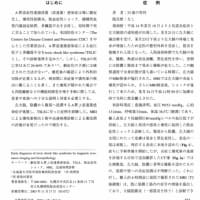 救急・集中治療 人食いバクテリアの診断と治療
7ヶ月前
救急・集中治療 人食いバクテリアの診断と治療
7ヶ月前
-
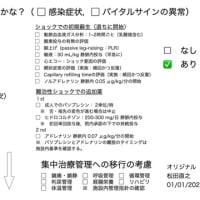 救急・集中治療 人食いバクテリアの診断と治療
7ヶ月前
救急・集中治療 人食いバクテリアの診断と治療
7ヶ月前
-
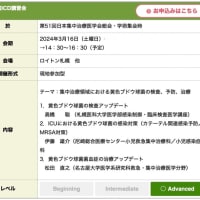 謹賀新年 2024年
7ヶ月前
謹賀新年 2024年
7ヶ月前
-
 謹賀新年 2024年
7ヶ月前
謹賀新年 2024年
7ヶ月前
-
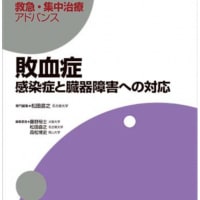 【WEBセミナー】Global Sepsis Allianceからのお知らせ
8ヶ月前
【WEBセミナー】Global Sepsis Allianceからのお知らせ
8ヶ月前
「ジャーナルクラブ 松田直之指導」カテゴリの最新記事
 ジャーナルクラブ Am J Physiol Lung Cell Mol Physiol 2012年12月号 Sonic Hed...
ジャーナルクラブ Am J Physiol Lung Cell Mol Physiol 2012年12月号 Sonic Hed... 2012年12月13日 基盤ジャーナルクラブ 心血管基礎研究関連
2012年12月13日 基盤ジャーナルクラブ 心血管基礎研究関連 文献紹介 Hypoglycemia and Risk of Death in Critically Ill Patients N Engl J...
文献紹介 Hypoglycemia and Risk of Death in Critically Ill Patients N Engl J... ジャーナルクラブ Am J Physiol Lung Cell Mol Physiol 2012年11月号
ジャーナルクラブ Am J Physiol Lung Cell Mol Physiol 2012年11月号 ジャーナルクラブ Circulation Res 2012, September 14 & 28
ジャーナルクラブ Circulation Res 2012, September 14 & 28 ジャーナルクラブ British J Pharmacol 2012. October Volume 167, Issue 3
ジャーナルクラブ British J Pharmacol 2012. October Volume 167, Issue 3 ジャーナルクラブ Am J Physiol Lung Cell Mol Physiol 2012年9月号
ジャーナルクラブ Am J Physiol Lung Cell Mol Physiol 2012年9月号 ジャーナルクラブ Circulation Research 2012. August
ジャーナルクラブ Circulation Research 2012. August ジャーナルクラブ British Journal of Pharmacology 2012. September
ジャーナルクラブ British Journal of Pharmacology 2012. September ジャーナルクラブ Am J Physiol Lung Cell Mol Physiol 2012年7月号
ジャーナルクラブ Am J Physiol Lung Cell Mol Physiol 2012年7月号

















